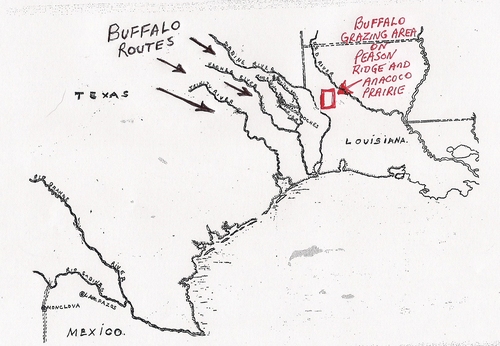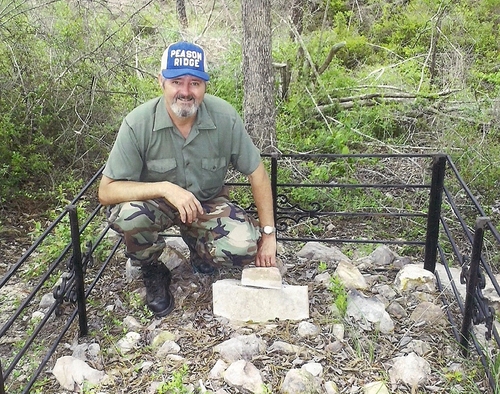BY RICKEY ROBERTSON
Many people have never thought that here in Louisiana there were at one time large herds of buffalo. Yes, on Peason Ridge and the Anacoco Prairie vast herds of these great beasts would come and winter. The buffalo would travel from the Great Plains and would ford the Trinity, Neches, Angelina, and Nacogdoches Rivers and then they would arrive at the Sabine River, where they would ford that last river and would then be in their winter grazing grounds. This area was almost like the Great Plains, with large cleared highlands filled with grass, large areas of sage grass that looked just like the plains, and in and around the rock hills and canyons there were valleys filled with enough grass for the vast herds to forage upon for the whole winter. With the winters not being severe in this area, the buffalo could graze until spring, then they would begin their migration back through Texas and to the Great Plains.
Since buffalo was the most staple food for the Indians, this gives us insight into the many Native American areas that have been found throughout this large area. Wherever the food source, such as the buffalo were located, there would be tribes of various Native Americans who would hunt these great beasts and would be camped throughout the area. Gives us all a hint why there are so many artifact areas located here!
But there were others who hunted the buffalo for food also. Many of the original settlers in this area hunted the buffalo for meat and used the skins and other parts of the buffalo for various things. One such man who lived in this wilderness area was L. C. Curby. Mr. Curby had a small farm located just inside present day Natchitoches Parish, so close to the Sabine Parish line you could nearly throw a rock across it. Mr. Curby hunted and lived off the land, with some subsistence coming from crops he raised. But during the winter, his main food source was buffalo meat. The buffalo would scatter out over and around Mr. Curby's farm site that is now on the lands of the Kisatchie National Forest. The buffalo would cross the head of Simmons Creek and Middle Creek, near the Curby Farm and would then go and graze in the valleys and canyons surrounded by the many rock hills. The buffalo had a "run", the place they forded the creeks and came into the area. Mr. Curby for many years hunted the buffalo but gradually, the buffalo became fewer and fewer each winter as the buffalo hunters killed off the vast herds on the Great Plains.
And then, there was only one buffalo left in the whole area. What few buffalo that had wintered journeyed back to the plains, never to come back again, leaving only one buffalo. One day while hunting, Mr. Curby saw this buffalo crossing the creek and coming up the run toward him. Mr. Curby shot and killed the last known buffalo in this area. Mr. Curby had so much respect for the buffalo that had been such a food source for him, that his last request was to be buried right where he killed the last buffalo in Louisiana.
As a youngster we hunted all around the area of the old Curby Place. Many times we would stop and walk out to the little single grave in the pines with the small sandstone marker with "In Memory of L.C. Curby" scratched into it. My Pappaw Craft lived in the area and would always tell of the last buffalo and of Mr. Curby. Sadly, many years ago, someone tried to dig the grave up, since some people thought Mr. Curby had gold buried in his grave with him. But he was only a farmer without any riches. The US Forest Service came in and covered up the grave and put stones on it. Now, still located in the same site, members of Mr. Curby's Family have installed a nice metal wrought iron fence all around the gravesite and have added many more stones and rocks. It is a solitary grave marking the life of the last buffalo hunter in Louisiana.

